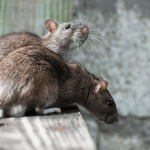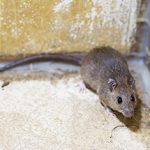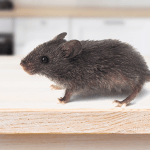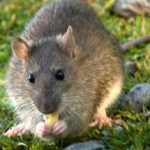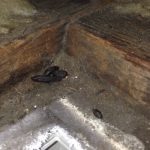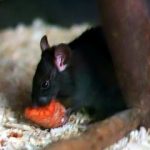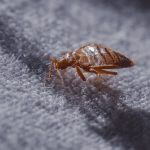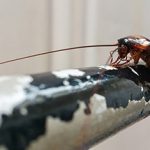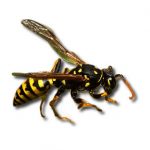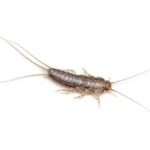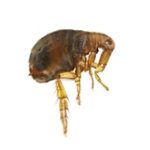Signs of Rats: Rat Infestation and Causes
Rats are one of the most troublesome household pests, capable of causing significant property damage and posing serious health risks. While they often remain hidden, their presence can be detected through specific warning signs like faint scratching on the walls, a strange smell near the pantry, or tiny dark droppings behind the fridge. Understanding why rats invade homes and how to spot an infestation early is crucial to preventing their spread.
Understanding the common causes of rat infestations and recognising the key warning signs will help you implement effective prevention strategies and have your home rat-free.
What are The Signs of Rats in the House
Rats are nocturnal creatures, meaning they are most active at night. However, they leave behind noticeable signs that indicate their presence.
- Rat droppings – one of the first signs of an infestation is the presence of rat droppings, which are small, oval-shaped, and dark in color. Usually, they can be found in areas with rat activity, such as behind appliances, under the sink, near food storage or in drawers or cupboards.
- Musky smell – rat urine has a strong ammonia-like odour, which becomes more intense as the infestation grows. Therefore, if you notice a persistent, foul smell in specific areas, it could be a sign that rats have made themselves at home.
- Gnaw marks – rats have strong teeth that continuously grow. To prevent their incisors from overgrowing, they gnaw on anything they can find. If you notice marks of rat bite on furniture, plastic, wooden surfaces, or electrical wiring, it’s a strong indication that rodents are present. However, chewed electrical cables not only indicate a rat problem but also increase the risk of house fires.
- Scratching or scurrying noises – since rats are most active at night, you might hear scratching, gnawing, or movement inside walls, ceilings, and floors while the house is quiet. If these sounds become more frequent or seem to be coming from multiple directions, it suggests an increasing rodent population.
- Footprints and tail marks – in dusty areas like attics, garages, and basements, you may find small rat footprints or tail drag marks. If you suspect an infestation, sprinkle some flour or powder in these areas overnight. If tracks appear the next day, it’s a clear sign of rat activity.
- Grease stains and rub marks on walls – while rats are relatively clean compared to mice, their fur still contains enough oil and dirt, and leaves dark grease marks along baseboards, walls, and floor edges. These greasy smudges typically appear near rodent pathways or access points, making it easier to locate rat nesting spots.
- Holes and burrows – rats often chew through walls, floors, and cabinets to create entry points. If you find small, rough-edged holes, particularly near food storage areas or along walls, they could be signs of an infestation. Outdoor burrows in, garden, near garbage bins and sheds can also indicate rat activity.
- Unusual pet behaviour – dogs and cats may become agitated or fixated on specific spots where rats are hiding.
- Nests and shredded materials – rats use shredded paper, fabric, and insulation to build their nests in hidden areas.
Read more: What is the First Thing You Should Do If You See Signs of Pest Infestation?
Why Would a Rat Come in My House?
Many things can cause a rat infestation. The primary reasons for rats to get a liking to your home are:
- Structural damage and entry points – Cracks in foundations, broken roof tiles, gaps around pipes, or even open vents provide an easy entry point for rats. They only need a hole the size of a coin to squeeze through. Especially vulnerable are homes with aging infrastructure, poor sealing, or inadequate maintenance.
- Clutter and nesting areas – A cluttered home creates the perfect hiding place for rats. Unused rooms, attics, and basements filled with old furniture, paper, and cardboard boxes give rodents the materials they need to build nests. The more clutter there is, the harder it becomes to detect an infestation before it grows out of control.
- Plumbing leaks & water sources – Like all living creatures, rats need a constant water source. Leaking pipes, dripping faucets, and standing water in basements or crawl spaces provide them with the hydration they need to survive. If a home offers both easy entry points and a water supply, it becomes an ideal nesting site for rats.
- Accessible food – Leaving food out in the open, such as pet food, unsealed pantry items, or uncovered garbage bins, attracts rats. Grains, cereals, dirty dishes in the sink and even crumbs on the floor create an easy food source, ensuring that rats not only enter the home but stay for the long term.
How to Know If a Rat Infestation is Growing
It’s nearly impossible to know how many rats are inside your property without a professional pest inspection. But the presence of even one rat is rarely an isolated incident. Rats are social, reproductive creatures that settle in quickly once they find warmth, food, and safety. And when they do, they breed rapidly.
A single pair of rats can produce dozens of offspring in just a few months. As the colony expands, the clues become difficult to ignore. You might notice more frequent droppings in new locations, louder and more persistent scratching noises at night, or increased sightings of gnawed materials and nesting debris.
A clear warning sign that the infestation is growing is seeing rats during the daytime. Rats usually remain hidden during daylight hours, but if their population becomes too large, some will be forced to venture out in search of food. If you spot a rat in broad daylight, it’s a strong indicator that the infestation has reached a level where internal space is running out. In this case, delaying action is no longer an option – it becomes a sanitary and structural emergency.
Rats don’t just multiply. They establish dominance over your home’s environment and increase contamination levels. The longer they are left untreated, the more damage they inflict – not just on property but on your health.
Rat Infestation Health Risks
Not just a nuisance rats, mice, and other rodents can carry serious bacterial and viral infections that affect both humans and pets. Understanding these risks can help you protect your family’s health and prevent further exposure. Common diseases transmitted by rats include:
Leptospirosis or Weil’s disease
Rats spread leptospirosis, which is one of the most serious diseases.This bacterial infection is primarily contracted through contact with rat urine or when people swim in, drink, or touch contaminated water.
Symptoms of Leptospirosis include high fever, muscle pain, and jaundice (yellowing of the skin and eyes). In severe cases, it can cause liver failure, kidney damage, or meningitis. Leptospirosis is a significant concern in areas with poor sanitation or in homes with standing water, where rats often live and breed.
Salmonellosis
Another major concern with rat infestations is Salmonellosis, caused by Salmonella bacteria. Rats contaminate food and water with their droppings, urine, and hair. This makes it easy for humans to contract the infection by consuming contaminated food or water.
Salmonellosis symptoms include diarrhea, abdominal cramps, fever, and vomiting. For individuals with weakened immune systems or young children, this illness can lead to severe dehydration and other complications.
Rat-bite fever
Bite or scratch from infected rats transmits the disease. Although it is rare, it can cause fever, joint pain, rashes, and potentially serious complications such as sepsis or organ failure. This infection can also be spread through contact with dead rats, including handling rat carcasses or coming into contact with their saliva or feces.
If you are bitten by a rat or have come into contact with a dead rat, it’s important to seek medical attention immediately to prevent infection.
Hantavirus
Although the Hantavirus is relatively rare in the UK, it’s still a disease to watch out for if you have a rat infestation. Certain species of rats carry Hantavirus, which can cause Hantavirus Pulmonary Syndrome (HPS) a severe respiratory illness.
The symptoms of Hantavirus include fever, fatigue, muscle aches, and shortness of breath. In severe cases, HPS can lead to acute respiratory distress syndrome (ARDS) and may be life-threatening. This virus is typically transmitted through the inhalation of dust contaminated with rat urine, droppings, or saliva, making it especially dangerous for those who live in dusty, neglected areas of the home.
Contamination of food and water
Rats are notorious for contaminating food and water sources, which can significantly contribute to the spread of diseases. Here’s how they do it:
Food contamination
Rats have easy access to food storage areas in homes, restaurants, and food processing facilities. They often contaminate food with droppings, urine, hair, and saliva, putting everyone who consumes the contaminated food at risk of gastrointestinal illnesses and other health complications. If you suspect a rat infestation, thoroughly inspect all food containers and dispose of any that appear compromised.
Water contamination
Rats can also contaminate water sources such as wells, storage tanks, and outdoor water supplies. When rats infest areas near water sources, they often urinate in or around these areas, causing contamination. Drinking water tainted with rat urine or feces can transmit diseases like Leptospirosis.\
Structural Damage Caused by Rats – Protect Your Property from Destruction
Whether you’re dealing with a small or large population of rats, they can cause substantial structural damage to both residential and commercial properties.
How Rats Damage Your Home and Property
Rats are notorious for their gnawing behaviour, and they will chew on just about anything they can find. They destroy everything from plastic bags and cardboard to furniture, paintings, and even important documents. This destructive behaviour is part of their nature. As rats’ teeth grow continuously, they have to gnaw on materials to wear them down.
But it doesn’t stop with just everyday household items. Rats and mice are especially dangerous to your home’s electrical systems. Their constant chewing on cables, wires, and plastic insulation can cause severe damage, leading to short circuits, electrical failures, and even fires.
Impact on insulation and building materials
Rats also chew through insulation materials found in attics or walls. When they damage insulation, it compromises a home’s energy efficiency, leading to higher utility bills and less comfortable living conditions. Over time, they can also cause structural weakness in walls, ceilings, or floors if left untreated.
The Risks to Office Spaces and Businesses
Office spaces are not immune to the dangers of a rat infestation. In fact, businesses are increasingly seeking office pest control services due to the potential damage rats can cause to IT infrastructure and office equipment.
Computer cables, internet wires, and telephone lines are particularly vulnerable to rat infestations. The rapid growth of rat teeth means that vital IT systems, network cables, and communication lines are at risk. Damaged wiring can disrupt business operations, leading to network failures, communication breakdowns, and loss of critical data. Additionally, furniture, fixtures, and even walls can become victims of rats’ insatiable chewing habits.
Preventing Property Damage from Rats
Addressing a rat problem quickly can help limit property damage and prevent costly repairs. Regularly inspecting for gnaw marks, chewed cables, and insulation damage can give you early warning signs of an infestation. Taking action to seal entry points and prevent access to food and water can also help to deter rodents from causing further harm.
How do you check if you have a rat?
Regular inspections are an essential step in preventing rat infestations, even if you haven’t yet noticed any signs of rodents. When conducting a DIY inspection, wear rubber gloves and a face mask to avoid exposure to harmful bacteria. Use a flashlight to check dark areas, including attics, basements, and crawl spaces. Look for droppings, gnaw marks, footprints, and grease stains, especially in cluttered storage spaces and near food sources.
Read more: Rat prevention methods.
Indoor Inspections – Where to Look for Rats
Rats are known for their stealthy behaviour, so even if you don’t see them, their presence can still be felt through the signs they leave behind. When inspecting your home, start with the areas that offer the most harborage opportunities like:
- Attics and basements – Rats prefer to nest in quiet, undisturbed spaces, so these are the top-priority areas for rat inspections. Look for gnaw marks on walls, rat droppings scattered in corners or hidden areas, nsting materials such as shredded paper or insulation.
- Walls and floors – Check for holes or openings in walls, floors, or ceilings.
- Kitchen and food storage areas – Rats are attracted to food, so the kitchen is often one of the first places they invade. During your inspection, check under appliances and inside cupboards for droppings, gnaw marks, or food scraps. Look for chewed packaging or open food containers that may have attracted rats, and ensure any plumbing leaks are repaired, as water sources attract rodents.
Where to Look for Rats Outside
Rats don’t just stay indoors – they can also cause significant damage outdoors, especially if your property offers easy access to food or shelter. Here’s where to focus:
- Garden areas and burrows – If you have a garden or vegetable patch, check for visible burrow entrances or disturbed soil, rat tracks near fences or walls, and gnaw marks on plants, fruit, or vegetables.
- Garden sheds – Rats are attracted to garden sheds, especially if they’re used to store items like tools, furniture, or even pet food. Look for nests made of shredded paper, fabric, or plant matter, gnaw marks, rat droppings or urine stains.
Garbage bins and waste areas – Inspect garbage bins regularly, especially if they are left uncovered or overflowing. Check for signs of chewing on bin bags or container edges, rat droppings around the bins, evidence of nesting near trash piles or recycling areas.
Conclusion
Rats are a serious problem that can damage your home, spread diseases, and increase your risk of electrical fires. The earlier you recognise the signs of a rat in your house, the quicker you can take preventative action to safeguard your property and family.
By staying vigilant and performing regular inspections, you can detect the problem early, minimising damage and health risks. If an infestation is confirmed, act quickly – contact a professional rat exterminator to eliminate the issue before it escalates and to ensure a pest-free environment.
We provide helpful information according to the expertise and knowledge of the pest technicians. However, we don’t offer any medical advice.



